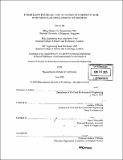| dc.contributor.advisor | Andrew J. Whittle and John T. Germaine. | en_US |
| dc.contributor.author | Ho, Chu Eu | en_US |
| dc.contributor.other | Massachusetts Institute of Technology. Dept. of Civil and Environmental Engineering. | en_US |
| dc.date.accessioned | 2008-11-10T20:02:40Z | |
| dc.date.available | 2008-11-10T20:02:40Z | |
| dc.date.copyright | 2005 | en_US |
| dc.date.issued | 2005 | en_US |
| dc.identifier.uri | http://dspace.mit.edu/handle/1721.1/32416 | en_US |
| dc.identifier.uri | http://hdl.handle.net/1721.1/32416 | |
| dc.description | Thesis (Sc. D.)--Massachusetts Institute of Technology, Dept. of Civil and Environmental Engineering, 2005. | en_US |
| dc.description | Includes bibliographical references (p. 267-271). | en_US |
| dc.description.abstract | This thesis reviews the jet grouting methodology, and the current state of practice and research. Current methods of prediction of jet grout diameters are highly empirical and site specific, and do not take into account the jet hydrodynamics and soil properties explicitly. A rational model to describe the jet excavation mechanism for cohesive soil is presented in this thesis, with the aim of providing an improved prediction tool that can be used in jetting design. The model is based on the assumption that the velocity distribution in the cutting jet is equivalent to that of a free jet with boundaries corresponding to the dimensions of the cavity excavated in the ground. The shape of the cavity formed depends on the erosional properties of the soil and jet expansion is limited by the resistance at the jet-soil interface. It is hypothesized that the shape of the cavity excavated follows the locus of the jet radius satisfying the condition of constant wall shear stress. The model predicts that the limit of jet penetration is reached when the dynamic pressure at the jet tip becomes equal to the ultimate soil bearing resistance. The model was validated by laboratory jetting tests, using soil specimens manufactured from powdered kaolin clay, cement and water. Cement-soil ratios (CSR) of 2.5 to 7.5% were used to produce specimens with undrained shear strength (Su) ranging from 5 to 45 kPa. A period of at least 3 days was allowed for the specimen to cure in the test tank before jetting was commenced. The tests were conducted using different nozzle diameters, jetting pressures, rotation speeds and soil strengths. The specimens were exhumed after completion of each test to map the shape of the cuts excavated. | en_US |
| dc.description.abstract | (cont.) The insitu shear strength of the specimens was obtained using torvane and laboratory vane shear tests. Samples were also obtained for density and moisture content measurements. The experimental results showed that the measured and predicted shapes of cut were in reasonable agreement, with the predicted jet width being conservative in most cases. A strong linear correlation was found between jet penetration, nozzle diameter, nozzle pressure difference and soil bearing capacity. It was found that a bearing capacity coefficient (Sc) of 2.4 was applicable for failure at the jet tip. This value of Sc was corroborated by field trial data. Wall shear stresses back-calculated from the experiments were much smaller than the residual soil strengths obtained from laboratory vane shear tests and correspond more closely to the erosional strength of clays. The model enables the lift step of the jetting monitor to be computed directly. The present research demonstrated that valuable information regarding the excavation mechanism can be obtained by careful examination of the actual cut in a soil formed by a jet. It is recommended that further work be done to investigate the erosional process at the jet-soil interface and the properties of the grouted soil, using higher jetting pressures and soils with higher shear strengths. The effect of withdrawal rate on column formation and uniformity of mix is of interest. The brittleness of the grouted product and its effect on strength and deformation behavior is also important. | en_US |
| dc.description.statementofresponsibility | Chu Eu Ho. | en_US |
| dc.format.extent | 456 p. | en_US |
| dc.language.iso | eng | en_US |
| dc.publisher | Massachusetts Institute of Technology | en_US |
| dc.rights | M.I.T. theses are protected by
copyright. They may be viewed from this source for any purpose, but
reproduction or distribution in any format is prohibited without written
permission. See provided URL for inquiries about permission. | en_US |
| dc.rights.uri | http://dspace.mit.edu/handle/1721.1/32416 | en_US |
| dc.rights.uri | http://dspace.mit.edu/handle/1721.1/7582 | en_US |
| dc.subject | Civil and Environmental Engineering. | en_US |
| dc.title | Turbulent fluid jet excavation in cohesive soil : with particular application to jet grouting | en_US |
| dc.type | Thesis | en_US |
| dc.description.degree | Sc.D. | en_US |
| dc.contributor.department | Massachusetts Institute of Technology. Department of Civil and Environmental Engineering | |
| dc.identifier.oclc | 61697404 | en_US |
